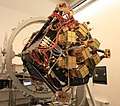eROSITA
eROSITA is an X-ray instrument built by the Max Planck Institute for Extraterrestrial Physics (MPE) in Germany. It is part of the Russian-German Spektr-RG space observatory, which also carries the Russian telescope ART-XC. It was launched by Roscosmos on 13 July 2019 from Baikonur, and deployed in a 6-month halo orbit around the second Lagrange point (L2).[3]
 | |
| Manufacturer | Max Planck Institute for Extraterrestrial Physics |
|---|---|
| Instrument type | Wolter |
| Function | X-ray all-sky survey |
| Mission duration | > 7 years [1] |
| Website | www |
| Properties | |
| Mass | 810 kg (1,790 lb) [1] |
| Dimensions | 1.3 m × 2.6 m [1] |
| Number launched | 7 mirror modules |
| Power consumption | 550 W [1] |
| Resolution | 15 arcsec (at 1.5 keV) |
| Spectral band | X-rays, 0.2 - 10 keV |
| Host spacecraft | |
| Spacecraft | Spektr-RG |
| Operator | |
| Launch date | 13 July 2019[2] |
| Rocket | Proton-M [3] |
| Launch site | Baikonur 81/24 |
| Orbit | Second Lagrange point (L2) |
Overview
eROSITA was originally studied by ESA for the International Space Station, and it was concluded in 2005 that its accommodation on a dedicated free flyer would provide significantly improved scientific output.[4] The eROSITA telescopes are based on the design of the ABRIXAS observatory launched in April 1999, whose battery was accidentally overcharged and destroyed three days after the mission started.[4]
eROSITA is imaging the entire sky in the X-ray band over a 7-year period. The eROSITA all-sky survey (eRASS) is first image of the entire sky in the 2-10 keV band. In the 0.3-2 keV band, it is expected to be 25 times more sensitive than the pioneering ROSAT mission of the 1990s, and will effectively supersede it.[5] eROSITA is expected to detect 100,000 galaxy clusters, 3 million active galactic nuclei and 700,000 stars in the Milky Way. The primary science goal is to measure dark energy through the structure and history of the Universe traced by galaxy clusters.
eROSITA achieved first light 17 October 2019[6], and completed its first all-sky survey on June 11, 2020[7].
Construction
The telescope consists of seven identical Wolter-type mirror modules with 54 nested gold-coated mirrors. The mirrors are arranged to collect the high-energy X-ray photons and guide them to the eROSITA X-ray sensitive cameras. The cameras were also custom-built at MPE, with X-ray CCDs manufactured from high-purity silicon. For optimum performance, the cameras are cooled to −90 °C (−130 °F; 183 K).[8]
 The seven mirror modules from the front
The seven mirror modules from the front X-ray detectors behind each mirror
X-ray detectors behind each mirror
Instruments
| eROSITA[1] | ART-XC | |
|---|---|---|
| Organisation | Max Planck Institute for Extraterrestrial Physics | IKI / VNIIEF |
| Telescope type | Wolter | Wolter |
| Wavelength | X-ray | X-ray |
| Mass | 810 kg | 350 kg |
| Sensitivity range | 0.3 - 10 keV | 6 - 30 keV |
| View angle | 1 degree | 30 minutes |
| Angular resolution | 15 seconds | 45 seconds |
| Sensor area | 2,400 cm2/ 1 keV | 450 cm2/ 8 keV |
Collaboration
eROSITA was developed at the Max Planck Institute for Extraterrestrial Physics in collaboration with institutes in Bamberg, Hamburg, Potsdam und Tübingen. The instrument principal investigator is Peter Predehl. The project scientist is Andrea Merloni. The German eROSITA consortium has members from institutes all across Germany, but also from international institutes, and has established collaborations with ground-based telescopes for follow-up observations of the millions of sources that will be detected by eROSITA.

Science results
First science verification results were released on October 22, 2019[9], including high-resolution spectra of Supernova 1987a, images of the Large Magellanic Cloud and galaxy clusters, as well as light curves of a highly variable Active Galactic Nuclei.

The first all-sky survey was completed on June 11, 2020[10], cataloging 1.1 million sources, including mostly Active Galactic Nuclei (77%), stars with strong, magnetically active hot coronae (20%) and clusters of galaxies (2%), but also bright X-ray binaries, supernova remnants, extended star-forming regions as well as transients such as Gamma-Ray Bursts[11]. The map includes extended features of the Milky Way, including mushroom-like bubbles and absorbing galactic gas in the disk (blue)[12].

References
- eROSITA Technical Performance. Max Planck Institute for Extraterrestrial Physics. Accessed on 14 June 2019.
- "Новости. О пуске ракеты-носителя "Протон-М"". www.roscosmos.ru. Retrieved 12 July 2019.
- Zak, Anatoly (16 April 2016). "Spektr-RG to expand horizons of X-ray astronomy". Russian Space Web. Retrieved 16 September 2016.
- "Spectrum-RG/eRosita/Lobster mission definition document". Russian Space Research Institute. 2005-10-30. Retrieved 2011-02-04.
- Castelvecchi, Davide (11 June 2019). "Space telescope to chart first map of the Universe in high-energy X-rays". Nature. Retrieved 14 June 2019.
- https://spaceflightnow.com/2019/10/23/german-x-ray-telescope-achieves-first-light/
- https://www.bbc.com/news/science-environment-53102718
- Merloni A, Predehl P, Becker W, Böhringer H, Boller T, Brunner H, Brusa M, Dennerl K, Freyberg M, Friedrich P, Georgakakis A, Haberl F, Hasinger G, Meidinger N, Mohr J, Nandra K, Rau A, Reiprich TH, Robrade J, Salvato M, Santangelo A, Sasaki M, Schwope A, Wilms J, et al. (German eROSITA Consortium) (2012-09-20). "eROSITA Science Book: Mapping the Structure of the Energetic Universe". arXiv:1209.3114 [astro-ph.CO].
- Predehl, Peter (11 June 2019). "Revealing the Beauty of the Hidden Universe: eROSITA sees first light". Max Planck Institute for Extraterrestrial Physics. Retrieved 19 June 2020.
- Merloni, Andrea (19 June 2020). "Our deepest view of the X-ray sky". Max Planck Institute for Extraterrestrial Physics. Retrieved 19 June 2020.
- Merloni, Andrea (19 June 2020). "Presskit for the eROSITA First All-Sky Survey". Max Planck Institute for Extraterrestrial Physics. Retrieved 19 June 2020.
- Amos, Jonathan (19 June 2020). "Breathtaking new map of the X-ray Universe". BBC News. Retrieved 19 June 2020.